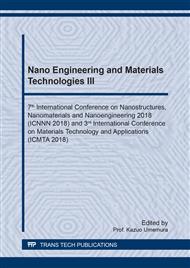p.173
p.178
p.185
p.190
p.195
p.200
p.207
p.212
p.217
Tensile Properties and Dynamic Mechanical Behaviour of Natural Rubber Compound Filled with Rice Husk Silica Produced via Solvent-Thermal Extraction Method
Abstract:
This study highlighted the effect of incorporation of rice husk silica (RHS) on the tensile properties and dynamic mechanical behaviour of natural rubber (NR) compounds. High purity RHS was synthesised by solvent-thermal extraction method, which was inspired by TAPPI T204 cm-97 and TAPPI T264 cm-97 standards with some modifications. The extraction method had successfully produced RHS with 99.9% of silica content and surface area of 234.25 m2/g. The incorporation of RHS in NR showed increment in tensile properties compared to unfilled NR. Further improvement was recorded by surface modification of RHS with 1 wt. % bis (triethoxysilylpropyl) tetrasulfide (TESPT). The modification of RHS with TESPT increased the rubber-filler interaction between RHS and NR matrix, hence enhancing the strength-related properties. The modified RHS-NR also recorded highest storage modulus, and the presence of RHS in the NR compound had slightly shifted the glass transition temperature (Tg) to a higher value. This confirmed that the strong rubber-filler interaction had increased the rigidity of the compounds and restricted the mobility of the rubber chains.
Info:
Periodical:
Pages:
195-199
Citation:
Online since:
March 2019
Price:
Сopyright:
© 2019 Trans Tech Publications Ltd. All Rights Reserved
Share:
Citation:


